Что такое тиф draft
Все, что вы хотели знать о драфте, но боялись спросить.
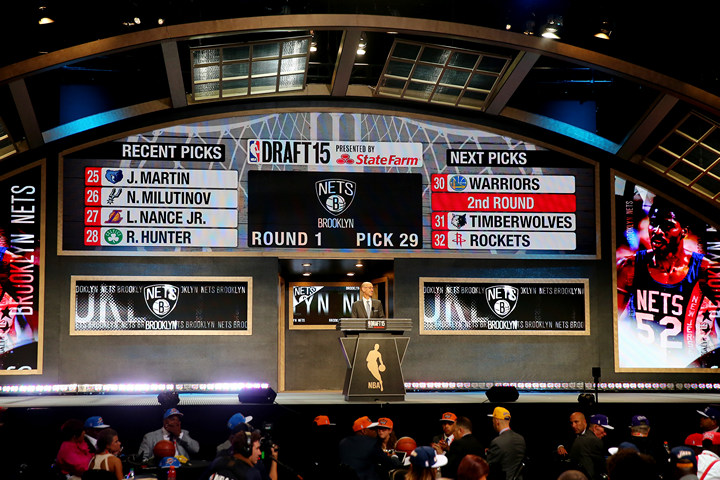
Текст-ликбез был впервые опубликован перед драфтом-2016
Сегодня состоится драфт НБА – событие, которох многих привлекает даже больше финальной серии, особенно болельщиков команд, не попавших в плей-офф или выбывших на ранних стадиях.
Что такое драфт?
Если вам привычна европейская система спорта, где из детей делают спортсменов в академиях и секциях, вы можете не сразу понять идею драфта. Но в Америке существует четкая вертикаль спорта, который интегрирован в систему образования: школы – университеты – профессиональный спорт. В разных видах спорта есть свои нюансы, но в баскетболе схема самая простая. После школы лучшим игрокам предлагают спортивные стипендии в университетах, соревнования которых курирует ассоциация NCAA, а уже оттуда студентов драфтуют команды НБА.
С 2022 года НБА планирует вновь разрешить игрока выставляться на драфт прямиком из школы, минуя колледж, как это делали Кобе Брайант, Кевин Гарнетт, Леброн Джеймс и другие в 1995-2005 годах.
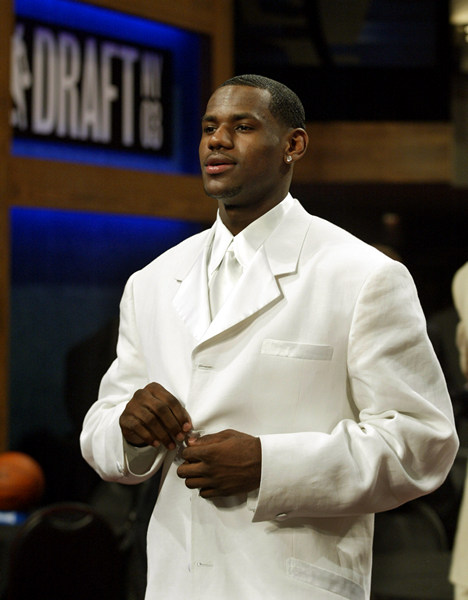
Как давно существует драфт?
Первый драфт НБА прошел после первого же сезона Ассоциации – в 1947 году. НБА взяла за основу систему любительского драфта из Национальной Футбольной Лиги, где та существовала с 1936 года: команды НФЛ распределяли права на футболистов, которые еще не были профессионалами. Если копаться глубже, то происхождение драфта лежит в бейсболе – с 1921 года клубы МЛБ проводили драфт игроков, выступавших в низших лигах.
Зачем он нужен?
Основная идея драфта – дать всем клубам шанс получить в состав сильного баскетболиста. Вся философия НБА строится на том, что изначально возможности всех команд равны. Драфт делает невозможным ситуацию, к которой мы привыкли в европейском спорте, где богатые клубы покупают лучших звезд, а в их академии и молодежные команды стоит длинная очередь из перспективных спортсменов. В НБА любой клуб может получить шанс получить права на будущую звезду, взяв ее на драфте.
Как определяются места на драфте?
Для чего нужна лотерея?
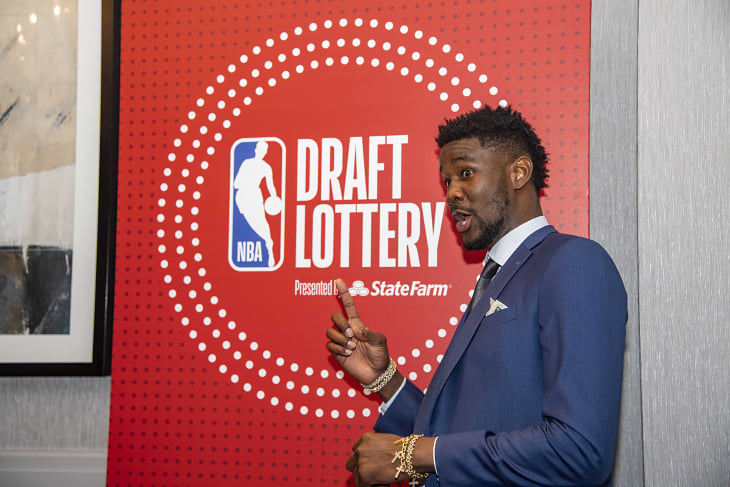
В 1985 году лига пришла к решению, что слепой жребий будет определять, в каком порядке будут выбирать не только последняя и предпоследняя команды лиги, но вообще все команды, не попавшие в плей-офф. В 1987 году систему откорректировали – неплейоффные клубы все также имели равные шансы на первый, второй и третий номера драфта, но после розыгрыша первых трех мест остальные выбирали в стандартном обратном порядке.
В 1990 году утвердили действующую до сих пор систему, в которой вероятность победы в лотерее была тем выше, чем хуже было место в таблице регулярного сезона. Проценты вероятности менялись год от года, самая свежая система с наиболее ровными шансами была введена только в этом году и призвана снизить число команд, намеренно проигрывающих ради высокого номера на следующем драфте (раньше худшая команда получала 25% шансов на первый пик).
Сколько человек будет выбрано сегодня?
Драфт НБА состоит из двух раундов (когда-то их число достигало десяти и более – команды выбирали, пока не надоедало, в 1988 году число раундов сократили до трех, а на следующий год – до двух). Поскольку в НБА 30 команд, то сейчас на драфте будет выбрано 60 человек. За каждым клубом закреплено по месту в первом и втором раундах.
Игроки из первого раунда драфта получают гарантированные контракты на два года в определенных суммах (у клубов также есть потом возможность продлить контракт на третий и четвертый сезоны), игроки из второго раунда подписываются с выбравшим их клубом на любые контракты, почти как свободные агенты.
Что происходит с теми, кого не выбирают на драфте?
Они становятся свободными агентами и вольны подписывать контракт с любой командой НБА, если та ими заинтересуется. Каждый год около 20 новичков, не выбранных на драфте, получают шанс сыграть в НБА.
То есть можно попасть на НБА и не через драфт?
Можно попасть в НБА, не будучи задрафтованным. Но все игроки были на драфте – просто их либо выбрали и закрепили за какой-то командой НБА, либо нет. О том, как именно баскетболисты попадают на драфт, рассказано чуть ниже.
Задрафтованные игроки будут в следующем году играть в НБА?
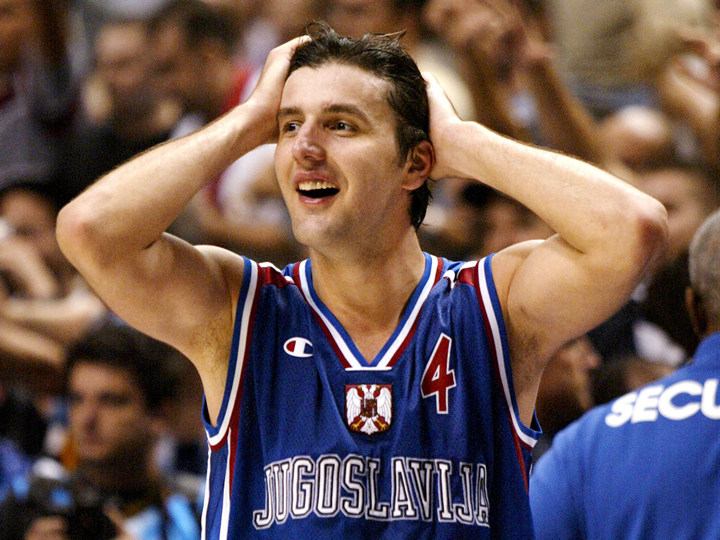
Но вот вернуться в колледж после драфта игрок уже не может – правила студенческой NCAA не позволяют баскетболистам, выходящим на драфт, изменить свое решение после определенной даты (в этом году дату – до 29 мая). Так что игрок, который выходит на драфт, после него обязательно становится профессионалом – в НБА или другой лиге. Он может продолжить обучение в колледже (если найдет на это время в плотном графике НБА), но лишится спортивной стипендии, будет вынужден сам платить за обучение и не сможет больше выступать за спортивные команды университета.
А если игрок откажется играть за клуб, который его выбрал?
У баскетболиста нет никаких рычагов по выбору клуба – он либо играет за ту команду, у которой есть права на него, либо не играет в НБА вообще. Но подобных скандалов не было давно – ни разу в XXI веке. Если игрок по какой-то причине не хочет выступать за выбравший его клуб, ему лучше полюбовно договориться с командой и своим агентом о том, чтобы его потом обменяли в другой клуб. А рисковать репутацией и портить отношения с НБА еще до своего дебюта никто не хочет. На кону теперь слишком большие деньги, чтобы так легко от них отказываться.
Как проходит церемония драфта?
Представители всех команд собираются в одном месте и начинают выбирать игроков по очереди. На выбор игрока в первом раунде дается 5 минут, по истечении которых менеджеры клуба должны принять решение и сообщить его комиссионеру НБА Адаму Сильверу. После этого Адам выходит на сцену, объявляет о выборе, приглашает игрока на рукопожатие (если игрок присутствует в зале), а отсчет 5 минут начинается для другой команды.
Во втором раунде уставшего комиссионера меняет его заместитель, на выбор дается всего 2 минуты, и игроков больше не зовут на сцену.
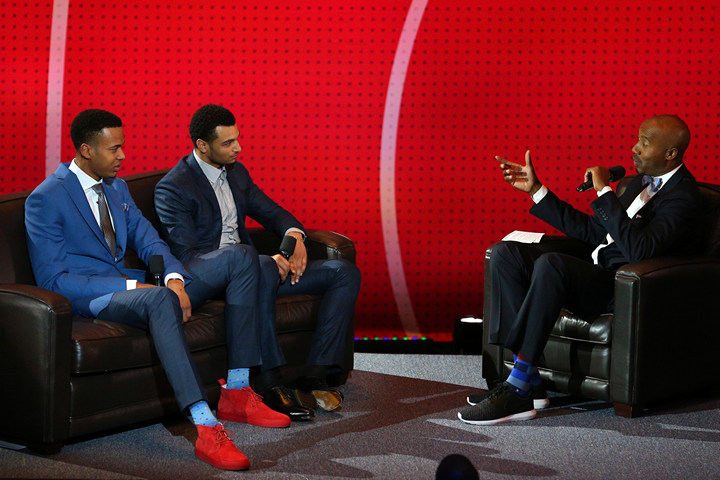
Насколько круто выбирать под первым номером?
Конечно, чем выше твой номер на драфте, тем больше шансов получить лучшего игрока. В разные времена под первым номером выбирались такие великие баскетболисты, как Карим Абдул-Джаббар, Мэджик Джонсон, Шакил О’Нил и ЛеБрон Джеймс (на фото).
Кроме того, достаточно часто бывают случаи, когда под высоким номером выбирают баскетболиста, который не оправдает надежд. Драфт и оценка перспектив игроков – это не точная наука, и тут постоянно бывают промахи, поскольку заглядывать в будущее спортивные менеджеры еще не научились.
А можно выбрать звезду под низкими номерами?
Конечно. Двукратный Самый ценный игрок НБА Стефен Карри был выбран лишь седьмым в 2009 году. Дирк Новицки – девятым в 1998. Кобе Брайант, один из самых популярных спортсменов в истории, когда-то упал до 13-го номера, как и легендарный Карл Мэлоун. Действующий чемпион и MVP финала НБА Кавай Ленард был выбран 15-м, уже после лотерейных пиков, как и Яннис Адетокумбо. Никола Йокич и Дрэймонд Грин вообще были выбраны лишь во втором раунде драфта, где стабильно каждый год появляется баскетболист, способный в будущем стать лидером команды.
А кто должен стать звездой с драфта-2019?
Как игроки попадают на драфт?
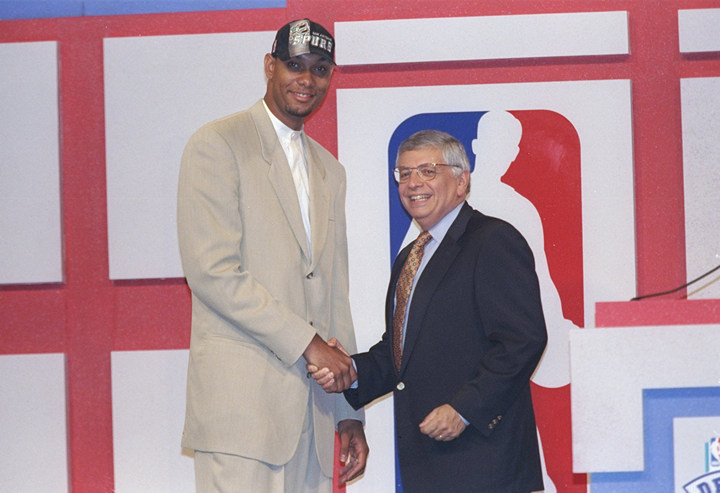
Что такое автоматический выход на драфт?
Автоматом на драфт попадают две категории игроков:
- Те студенты, кто отыграл четыре сезона в NCAA – такими были Тим Данкан (на фото) в 1997, Дрэймонд Грин в 2012, в этом году – гигант Тако Фалл.
- Ранее не бывшие на драфте игроки, выступающие за рубежом, кому в год драфта исполняется 22 – то есть сейчас это баскетболисты из Европы, Азии, Латинской Америки, Австралии, Африки и так далее 1997 года рождения.
Также автоматически попадают на драфт те, кто отучился в американской школе или университете, а затем перебежал на профессиональный контракт за рубеж. После года выступления в профессионалах такие игроки выходят на драфт – случаи редкие, но не исключительные (Брэндон Дженнингс в 2009, Эммануэль Мудиай несколько лет назад).
Как подать заявку на драфт?
Для подачи такой заявки игроку должно быть минимум 19 лет в год драфта – и он должен либо играть за рубежом, либо быть студентом. Студенты из NCAA могут подать заявку уже после первого курса. В последние девять драфтов под первым номером выбирались исключительно первокурсники.
Игрок не может попасть в НБА, минуя драфт. Каждый человек либо выходит туда автоматически после окончания колледжа или по возрасту в 22 года, либо хочет сделать это раньше и подает заявку. Все игроки НБА – и вообще все люди старше 22 лет – были на драфте, просто кого-то выбрали, а кого-то нет.
Сколько раз игрок может выставлять заявку на драфт?
Я могу подать заявку на драфт?
В этом году, конечно, уже нет, срок подачи заявок давно прошел. Но в следующем – если вы родились в 1998, 1999 или 2000 году или же закончили школу в США в 2019 году – вы можете отправить заявку на драфт НБА. Уметь играть в баскетбол для этого на самом деле необязательно. А в 22 года мы все автоматически были/будем на драфте, даже безо всяких заявок.
Русские есть на этом драфте?
Только те, что выходят автоматически, поскольку они 1997 года рождения. Ни у кого из них нет шансов быть выбранным.
А русских выбирали на драфте?
Еще в 1975 году на драфте в десятом раунде был выбран Александр Белов. Конечно, в НБА он из СССР не уехал. В 1986 году на драфте появились и другие легендарные советские баскетболисты – Cабонис, Волков, Тихоненко. Но иностранцы поехали в НБА только в 1988 году, и уже после распада Советского Союза клубы стали драфтовать наших соотечественников с конкретной целью пригласить в НБА.
Вот кто был выбран на драфте:
Остальные, включая Шведа, Базаревича и чемпиона НБА Тимофея Мозгова, задрафтованы не были и подписывались как свободные агенты. Боломбой, Маккарти и Хансен становились россиянами уже через годы после драфта НБА.
Во сколько завтра драфт и где его смотреть?
Церемония драфта начнется в 2:30 ночи c четверга на пятницу по Москве, а смотреть можно, оформив подписку на сервис NBA League Pass.

LaMelo Ball of the Illawarra Hawks in the Australian Basketball League on Nov. 17, 2019. Credit: AP/Rick Rycroft
The NBA Draft is always a mystery trying to detect the potential of an 18-year-old player based on a handful of Euroleague games or a year of college ball. But this season is especially strange.
When the draft will be held and how the scouting for it will be done is an unknown with the NBA season shut down for the coronavirus pandemic. And the usual time to see the best players in pressure situations - the conference tournaments and the NCAA Tournament - were canceled.
And for Leon Rose, it is at another level. Rose officially took over as Knicks team president on March 1 and just who will join him in the front office remains a mystery - a lame-duck crew still in place with expiring contracts. So he is preparing for a crucial draft with a lottery pick, a late first-round choice and a top 10 second-round pick and is unsure of who’s scouting advice he’s relying on, who will be making the pick and how they will judge those players.
With the lottery not yet held and the NBA still holding out hope of a return to finish out the season, just where teams will be picking is a mystery, too. But here’s a look at some of the best lottery talents.
You can point out all of the flaws and questions - shooting 25 percent from three-point range in his season as a professional overseas, the distractions that his father has created in the past and the showtime over fundamentals aspects of his game. But in a draft that is loaded with players who are ordinary for their position, Ball is the one with freakish potential -- a 6-foot-7 point guard with instincts, flash and skill -- the one who could either be a flop or make critics wonder for decades how he was passed over.
He’s the top pick in plenty of mock drafts and with good reason. Athletic, strong and with a game that reminds scouts of Dwyane Wade. But what he doesn’t have yet is a polished game or the three-point shot expected of today’s wings. He has showed the range from deep, just not the consistency.
By clicking Sign up, you agree to our privacy policy.
In another time, maybe even just a few years ago, Wiseman would be the unquestioned No. 1 overall pick. Even in an abbreviated season cut short after just three games with Memphis, he showed big man skills that are rare, combining athleticism and an NBA body with fundamentals as he posted up. But in an NBA where centers, particularly low-post centers, are being phased out, does he still merit a top-three pick?
Lightly recruited out of high school, Toppin has emerged as this year’s daily highlight reel - dunking everything around the rim. Still raw in many ways but scouts believe he has the potential to be a solid defender and turn his limited outside shooting into a steady weapon.
He’s been on the radar of NBA teams, winning MVP honors at the FIBA U20 European Championship and also at the NBA’s Basketball Without Borders competition in 2019. Skilled ball handler and shooter (although oddly shot just 52 percent from the free-throw line this season).
He entered college regarded by some as the top player in his class and certainly the top point guard. But he endured injuries and a horrific season by the Tar Heels, losing some luster on his potential as he was a one-man show at times with little help. Still, he showed the defensive intensity his dad, former Knick Greg Anthony, displayed and much more potential offensively.
Maybe the best passing point guard in the draft, Halliburton led the nation with 6.5 assists per game and did it with a flare that made many of them memorable. He shot 41.9 percent from beyond the arc and carried the team -- playing in every minute of the game 10 times, including a 45-minute appearance in an overtime win over TCU in which he posted a triple double -- before his season ended with a fractured left wrist.
Want to find the next Mitchell Robinson? Try Okongwu, who shot 61.5 percent from the floor -- and 80 percent from the line -- showing an ability to dunk everything, run the floor well and defend capably. The downsides: He hasn’t showed an ability to move away from the basket offensively and he turns the ball over at an alarming rate.
The French-born 18-year-old doesn’t have crazy numbers but displayed instinctive passing skills and has the size and athleticism to get to the rim and merits a spot in the top 10.
He didn’t grow up playing professionally overseas - his Italian roots coming only from being born there when his father, Pace Mannion, played their professionally after a six-year NBA career. But Mannion’s game looks like someone who has, displaying a skilled and stable game that doesn’t match his youthful looks. The 19-year-old has poise but needs that to make up for ordinary speed and athleticism.
Strong and athletic, Okoro showed the ability to get to the rim and to shoot from the perimeter. For his size and strength, he showed playmaking ability this season as a freshman.
Texas high schooler who opted to play pro this season and spent 15 games with the Breakers before heading home to prepare for the draft. The slender 19-year-old slashes well to the rim and shoots better than his numbers.
Slender scorer with the ability to get to the rim and shoot from outside the arc, McDaniels draws some optimistic comparisons to Kevin Durant. Still raw with a propensity for turnovers and struggling against physical defenders.
The son of an NFL offensive lineman and it shows with a game that resembles football at times more than basketball, befitting his 260-pound frame. More old school than new NBA with a back to the basket game.

Steve Popper covers the Knicks for Newsday. He has spent nearly three decades covering the Knicks and the NBA, along with just about every sports team in the New York metropolitan area.
Max Freund | Staff Photographer
The Daily Orange asked three draft analysts to evaluate Elijah Hughes, who still hasn’t decided as to whether he will remain at Syracuse.
Early Monday morning, Elijah Hughes became the third Syracuse basketball player in the last seven years to be named to the All-Atlantic Coast first team. That’s a feat accomplished by neither Tyus Battle nor Oshae Brissett, the two players who Hughes played a secondary role to in his first season as a contributor for the Orange.
Hughes recently scored his 1000th point at Syracuse and has come a long way from the overlooked prospect who spent much of his career as an under-the-radar role player.
Hughes still has the option to return to SU for his redshirt senior season, but NBA Draft experts have kept close attention to Hughes’ quick rise. The Daily Orange interviewed three NBA Draft experts on how real that attention is. Here is a breakdown of Hughes’ status as an NBA Draft prospect.
The Daily Orange: What is the first thing that stands out about Hughes?
Paul Biancardi, ESPN: “He has NBA (3-point) range right now. And that’s attractive to the NBA. The shot at that distance is not a problem. Now, there needs to be a consistency behind that long range that will come over the course of time. But the hard part, he already has down. He’s a very good straight-line driver with a lot of speed. So if you take that 3-point shot away — a lot of teams like to run him off the line — his ability to shot-fake or his ability just to grab it, sweep it across his body and go with a straight-line drive. Excellent speed. And then he has that athleticism to punch it down and finish.”
Matt Babcock, Babcock Hoops: “I did not have high expectations for this year’s Syracuse team prior to the season. They have done well, and I think a lot of credit needs to be given to Hughes. He has been impressive all season.”
Lorenzo Neri, L’Ultimo Uomo (Italy): Note from Writer — Neri had watched Hughes play live when the Orange took their preseason trip to Italy. “Back to last summer, the first thing that jumped about Elijah was the combination of power, agility and skills. He has this linebacker body type, strong with low center of gravity that allows him to play through contact and against bigger players.”
D.O.: What is his best and worst trait?
P.B.: “He’s actually best off the ball. I like him coming off screens. Coming from dribble penetration and kick to him. So, I think he’s best moving, cutting, coming off screens. He’d be fantastic at what they call a simple wide pin-down where he’ll just curl into the lane, catch it and shoot it. With all that said, his middle game needs work. The dribble pull-up. And then obviously the ability to get in the lane and shoot a floater off of one foot. That’s probably the next part that needs to step up. Because you’re going to be in the NBA. Because they’re going to take away what you do best, so you have to counter it.”
M.B.: “Hughes is an aggressive, well-rounded scorer. He has a strong, sturdy build, handles the ball well, and has deep range. He tends to have a quick trigger, which is something that often times comes along with being an assertive scorer. I do think he could improve his shot selection. However, it’s not overly concerning, as the role he is playing for Syracuse is to be ‘the guy’; they clearly want and need him to aggressively pursue scoring opportunities.”
L.N.: “(His body) is a truly valuable skill for the NBA level, especially if you think of his skillset. What concerns me about his NBA future are two things: shooting (technique and selection) and defense. He has touch but his catch point and his release point are really low, and he’s not the tallest guy for a wing position.”
D.O.: Anything that he needs to show more of?
P.B.: “Especially in the NBA, you’re not going to get to the rim very often. That pull-up jump shot, it’s important to get into that rhythm and the practice habits of taking that shot. And the only way you take it is by practicing it. So that you get comfortable in it.”
M.B.: “Aside from his shot selection and just some basic decision-making, which can be said of just about any player at this stage in their career, there isn’t really one specific thing that I’d like to see from him. I think he has room for growth all around as any player does, but for the most part he is a pretty well-rounded player without any glaring weaknesses.”
L.N.: “He too often settles for the contested mid- and long-range jumper instead of attacking from the dribble, using his strength. I think that the shot selection and the defense adaptability certainly has something to do with (SU head coach Jim) Boeheim’s style of play on both ends of the floor.”
D.O.: Where would you expect to see him picked?
M.B.: “It’s an interesting time of the year in regards to projecting draft picks, as we are not certain exactly which players will return to school. Hughes is a player that we have not included in our mock draft up to this point, but if he does decide to be in this year’s draft, I would say that he would have a very good chance of being a second-round draft pick.”
L.N.: “In the end, I think he has the potential to be a good rotation player in the NBA. Maybe some team could spend a second-round pick on him… maybe he’s going to fight for a spot on an NBA team through Summer League, Training Camps and GLeague.”
- Biancardi noted that Hughes’ passing is an “underrated” aspect of the Syracuse forward’s game: “I think when you watch his shot, you don’t think about him passing, but he’s a guy who can really pass the ball.”
- Biancardi also addressed the size question: Whether or not Hughes’ 6-foot-6 height causes concern over what position he will play at the next level. He said that won’t be an issue: “They draft you based on what you do, not what you can’t do. And they figure out how to plug you into their system.
This interview has been edited for brevity and clarity.
Editor's note: As the Warriors prepare for the 2020 NBA draft, during which they will have a lottery pick for the first time since 2012, NBC Sports Bay Area will present a twice-weekly series spotlighting two players expected to be evaluated. This is the seventh of a 12-part series over a six-week span.
When the Warriors traded Andre Iguodala to the Grizzlies last summer, coach Steve Kerr needed a moment. Maybe two.
He understood the complexities of who Iguodala was, and for a variety of reasons, was closer to him than any other player on the team. Kerr described the move as “a gut punch.”
The Warriors have spent the past nine months scanning the market for someone with similar attributes and come up empty. Now preparing to assemble a roster for the 2020-21 season, they surely know of a young wing at Auburn who is in some ways reminiscent of Iguodala.
Meet Isaac Okoro, a 6-foot-6, 215-pound freshman wing whose athleticism -- 38-inch vertical leap -- and refined defensive mentality have moved him out of mid-first-round projections and into the lottery, where the Warriors currently sit.
In seeking a comparison for Okoro, Iguodala is among the names tossed out by NBA scouts and those who specialize in evaluating college talent. Among the other names are Toronto’s OG Anunoby and, at the top end, Jimmy Butler of the Heat and Kawhi Leonard of the Raptors.
Here is an analysis offered by The Stepien Report, which might be the most comprehensive independent evaluation service: A glue guy on offense . high IQ . high-level defensive player on and off the ball . active hands. Iguodala is mentioned as a comparison.
After leading McEachern High to a 32-0 record as a senior, Okoro entered his freshman season as a four-star prep recruit. He quickly proved capable of making five-star plays, everything from game-winners in the paint (vs. South Alabama) to pivotal 3-balls in the waning minutes (Kentucky) to posterizing dunks (Vanderbilt) to coast-to-coast from rebound on one end to crossover in the middle to rousing dunk at the finish (Alabama).
Despite having a jump shot that needs repair, Okoro finished his freshman season with a 112.8 offensive rating, ranking second in the SEC.
It’s his defense, though, that excites scouts. He was effective at guarding four positions for the Tigers and displayed a distinct feel for activity all across the floor.
The NBA has evolved into a league of wings and every team covets them, particularly those who can contribute on both ends. It’s a position of need for the Warriors, and they’ve made apparent their desire to add young players fitting that role.
Okoro fits. He’s the top small forward in some mock drafts, No. 2 on others.
The biggest knock on him, in addition to his inconsistent jumper, is that he is too deferential on offense. Okoro acknowledges he’s not a big scorer, that he’s more of a utility player on offense, a “Swiss-Army-knife” type capable of providing in several areas.
There is practically no chance Okoro will be the No. 1 overall pick. Not flashy enough on offense. But if the Warriors make a trade to move back a few spots, he’ll be on their radar.
Unlike the previous five springs, when the Warriors were preparing for the playoffs, Kerr has time to evaluate potential draft picks. Asked earlier this month which attributes he focuses on when studying video, Kerr told NBC Sports Bay Area earlier that he looks for two-way engagement, defensive fundamentals and willingness to share the ball.
If those qualities seem familiar, it’s because they are. They also match those of a former member of the Warriors, an NBA Finals MVP now on the roster of the Miami Heat.
Isaac Okoro profile
Position: Small forward
Class: Freshman
Birthdate: Jan. 26, 2001 (19)
Hometown: Powder Springs, Ga.
2019-20 stats: 12.8 points (51.2 percent FG, 28.6 percent 3p, 67.4 percent FT), 4.4 rebounds, 2.0 assists.
Height: 6-foot-6
Weight: 220
Wingspan: 6-9
What they’re saying: "He's an NBA player right now, but if he starts to get to the point where he can see it and make it, then he's an NBA All-Star. He's Victor Oladipo times two." – Auburn coach Bruce Pearl, assessing Okoro’s potential with a reliable jump shot.

Warriors general manager Bob Myers gave head coach Steve Kerr some homework last week: watch seven or eight prospects Golden State was zeroing in on with its first-round pick.
The NBA draft lottery won’t be held until May 19 at the earliest; the Warriors are on track to select no later than fifth.
According to multiple league sources, The Chronicle contacted in the past few days, the Warriors — contrary to what mock drafts might suggest — aren’t believed to be high on two of the three players being mentioned as possibilities at the No. 1 pick: former Memphis center James Wiseman and point guard LaMelo Ball, who last played for the Illawarra Hawks of Australia’s National Basketball League. As one source put it, “I think they’d only take one of those two if they were trading down in the draft and taking them for another team.”
With that in mind, Wiseman and Ball aren’t included in The Chronicle’s educated-guess list of what the Warriors call their “top tier” — the prospects they’d consider selecting with a top-5 pick:

Anthony Edwards, SG, Georgia (6-foot-3, 225 pounds, 18 years old): If the Warriors land the No. 1 pick in the draft, they’ll be open to trading it. But if Golden State doesn’t receive a worthy offer, it likely would take Edwards with the top selection, according to a league source.
Though Edwards doesn’t boast the efficiency, motor or winning pedigree teams want from a No. 1 pick, he has a good chance at developing into a high-usage shot-maker along the wing who also can defend multiple positions. Edwards’ projected ceiling is multi-time All-Star, and his floor is probably helpful rotation player.
The Warriors could do much worse than bringing him off the bench next season as a sixth or seventh man. And who knows? After a few years learning from Stephen Curry and Klay Thompson, Edwards might be ready to assume face-of-the-franchise responsibilities.

Deni Avdija, SF, Maccabi Tel Aviv (6-9, 215, 19): Avdija used a strong back half of the season in a top-flight overseas league to cement himself as the No. 1 international prospect in this class — not counting Ball, who grew up stateside — and a likely top-5 pick in June’s draft. Though Avdija projects as an average defender in the NBA based on his physical tools, he is an elite passer with a good feel for the game.
His experience in the EuroLeague should give him a chance to play rotation minutes as a rookie, but the Warriors are high on him because of his long-term upside. Avdija, simply put, is one of the few players in this draft with All-Star potential.
If Golden State decides to keep the pick after landing anywhere between No. 2 and No. 5, it will take a hard look at Avdija. One source told The Chronicle that some teams believe the Warriors could end up having Avdija No. 2 on their big board behind Edwards.

Isaac Okoro, SF, Auburn (6-6, 225, 19): Okoro wouldn’t be a flashy pick, but he could help the Warriors’ defense regain its luster. As a freshman at Auburn, he was one of the best defenders in college basketball, using balance and quick hands to change games on that end of the court.
Okoro’s jump shot needs plenty of work, but he has demonstrated a knack for the subtle plays — screens, box-outs, putbacks — that fuel winning teams. The question is whether his offense leaves too much to be desired for the Warriors to feel comfortable taking him in the top 5.
If Golden State traded down to the mid-to-late lottery and Okoro were available, it strongly would consider taking him. His floor is quite high for a 19-year-old.

Obi Toppin, PF, Dayton (6-9, 220, 22): Toppin has been linked to the Warriors for months for good reason. They’re trying to vault back into contention with a healthy Curry and Thompson next season, and no one in this draft class is better suited than Toppin to thrive in Golden State’s system as a rookie.
Fresh off leading Dayton to the Flyers’ best season in school history (29-2), the Associated Press men’s Player of the Year is a readymade offensive contributor (20 points per game, 63.3 shooting percentage). Toppin’s relatively weak lower body raises questions about whether he’ll be more than just an adequate defender at the next level. But in a draft littered with flawed prospects, Toppin is as close to a sure thing as Golden State will find.
That hasn’t prevented him from becoming one of the trickiest players to peg. At age 22, Toppin might not have the upside of younger prospects. Mock drafts have him going anywhere between No. 2 and the late lottery.

Tyrese Haliburton, PG, Iowa State (6-5, 175, 20): If the Warriors pick in the top 5, they’ll draft the best prospect available — not the player who fills a positional need. That means that even though Golden State already has Curry at point guard, it would be open to adding someone who could replace him someday.
According to a league source, the Warriors are believed to be higher on Haliburton than on Ball. There might not be a player in this draft with a better feel for the game than Haliburton, who, in addition to averaging 6.5 assists this season, shot 50.4% from the field (41.9% from 3-point range).
Though he’ll probably never be the face of a franchise, Haliburton projects as an important complementary player in the NBA. The Warriors could do far worse toward the end of the top 5 or, if they trade down, later in the lottery.

Killian Hayes, PG, Ratiopharm Ulm (6-5, 192, 18): Hayes might be the most complete point guard in this draft. As a high-usage playmaker in Germany’s top league, he played beyond his years, changing speeds with ease and dishing out 5.4 assists per game.
Though he’s still a bit left-hand dominant, Hayes has the craftiness and court awareness that NBA coaches want in their starting point guards. The problem is that, given the makeup of the Warriors’ roster, he might need to wait a few years to play big minutes.
That probably wouldn’t keep Myers from drafting Hayes, however. He is polished enough to supplant Jordan Poole and Ky Bowman as Golden State’s primary backup point guard from Day 1. By the time Curry’s production begins to decline, Hayes could be ready to lead the offense.

R.J. Hampton, PG/SG, New Zealand Breakers (6-5, 188, 19): In a draft loaded with question marks, sometimes the best approach is to take the player with the most untapped potential. That’s what the Bucks did in 2013 when, instead of opting for a more proven college player with the No. 15 pick, they took a gangly teenager out of the Greek second division named Giannis Antetokounmpo.
No one expects Hampton to be an Antetokounmpo-caliber player, but he possesses a combination of size, athleticism and ball-handling ability that could compel a team to use an early-to-mid lottery selection on him. Hampton averaged 9.6 points, 3.9 rebounds and 2.5 assists per game in Australia’s National Basketball League this season in what could have been his senior year of high school.
Though Hampton is still probably a year or two away from contributing to an NBA team, he has a chance to be great. And that’s something not many players in this draft can boast.
Читайте также:


